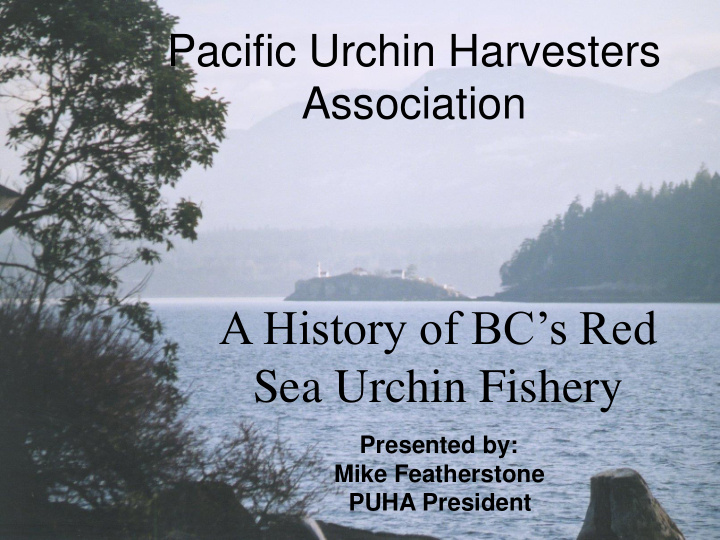



Pacific Urchin Harvesters Association A History of BC’s Red Sea Urchin Fishery Presented by: Mike Featherstone PUHA President
3 Pillars of the Pacific Urchin Harvesters Association (PUHA) • Sustainability • Maximizing Economic Value of the Catch • Increasing community awareness and knowledge of the industry
Early days (Pre-quota) 1971 - 1993 • Fishery grew slowly until the early 80’s. • Expanded rapidly until 1992 when fishery landed just under 29 million pounds. • Limited entry in 1991 • Late 80’s and into the early 90’s the management became more intensive • Relationship between managers and fishermen was uncooperative
Early days (pre-quota) • Pacific Urchin Harvesters Association was incorporated in 1992 • 1993 managers instituted a coast wide Total Allowable Catch and area selection which intensified fishing activities into the classic “Shot - Gun” style openings • poor safety practices, poor compliance to harvest regime and supply gluts (poor prices). • Up to 1994 license fees were $50 and PUHA fee was $25
Voluntary Individual Quota System 1994 - 1995 • January ‘94: 1 million lbs. landed in first few days • February fishermen stopped fishing and created Voluntary IQ System – VIQs included validation log, off load monitors, equal division of TAC • Financed by a fishermen imposed $.02/lb landing tax
Voluntary Individual Quota System: Impacts • No quota overages • Improved safety records • Increasing cooperation between managers and fishermen • Prices increased and market supply more consistent
Investing in Co-management • 1994 PUHA in co-operation with DFO, Community Groups and the Province of B.C. set aside 5 Experimental research management areas – Haida Fisheries Program, Kitasoo Fisheries Program, PUHA and DFO • Research funded 50% by Province of British Columbia – Partners In Progress Program
DFO Sanctioned IQ System 1996 – present • 1996: DFO officially sanctioned the Individual Quota system – license transferability was permitted • In addition to the off-load validation program DFO required an On-grounds Monitor (OGM) • 2% of the TAC was allocated for Native Food, Social and Ceremonial Use • 23 south coast fishing areas and 33 north coast fishing areas.
IQ System: 1996 - present • Prices increased steadily until 2002 and then stabilized • All licenses validated with PUHA until 2004 • PUHA administered program cost was $5,000/licence, • This increased to $5,321.36 in 2000 and $5,500 in 2002
PUHA Budget Breakout for 2006-07 – Forecast only 80 licenses will validate, – leaving a budget shortfall of $165,000
Today’s Fishery 2006 - 2007 • Fishery has evolved to a modern progressive fishery embracing co-management – Co-management involves commitment to core values, co-operation with DFO science and management • 34 South and 71 North coast fishing areas • 58 permanently closed areas • Current system of management and science is a role model for other fisheries
Today’s Fishery 2006 - 2007 • Market demand sporadic, prices trending lower since 2003 • Market limitations are making it ever more difficult for industry to fully fund all of the current science, management and operational commitments. • Challenge today is where do we go from here and “how will we do it?”
Recommend
More recommend